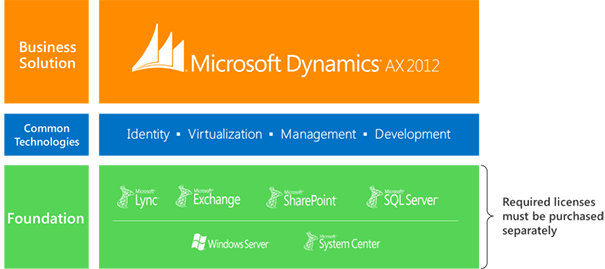Microsoft Dynamics AX Modules
Dynamics AX is such a powerful tool which contains 19 CORE Modules in it.
Following are the list of the modules Dynamics AX contains according to it's versions:
- General Ledger – ledger, sales tax, currency, and fixed assets features
- Bank Management – receives and pays cash
- Customer Relationship Management (CRM) – business relations contact and maintenance (customers, vendors, and leads)
- Accounts Receivable – order entry, shipping, and invoicing
- Accounts Payable – purchase orders, goods received into inventory
- Inventory Management – inventory management and valuation
- Master Planning (resources) – purchase and production planning
- Production – bills of materials, manufacturing tracking
- Product Builder – product mode creation and maintenance
- Human Resources – employee information
- Project Accounting – projects creation and tracking (primarily from an accounting perspective)
- Basic – data configuration
- Administration Module – system configuration
- Procurement and Sourcing
- Sales and Marketing
- Call Center - employees take orders over the phone and are able to create sales orders
- General Ledger - the ability to transfer opening balances in balance sheet accounts to a new fiscal year
- Inventory and Warehouse Management - compare item prices, enhanced posting routine and a new Inventory aging report
- Master Planning - estimate future demand and create demand forecasts based on transaction history
- Procurement and Sourcing - create your own solicitation request for RFQs, and more
- Production Control - a new option to automate material reservations
- Project Management and Accounting - new on-account billing rules and fee transactions that modify invoice proposal sales prices
- Public Sector - now able to publish a request for quotation (RFQ) to the Vendor portal and now have the ability to view details of closed RFQs
- Retail - commerce Data Exchange, updated retail server, new retail hardware station, and more
- Sales and Marketing - register serial numbers during sales processes when preparing the packing slip or the sales order invoice
- Transportation Management - plan transportation for inbound and outbound shipments, configure rating structures and view driver check-in and check-out history
- Trade Allowance Management - define merchandising events, manage trade fund budgets, process customer payments (including deductions, and more
- Warehouse Management - configure inbound and outbound intelligent workflows, use scanners/mobile devices to optimize precision in the picking and put-away processes, and more
- Shop Floor Control
- Cost Accounting
- Balanced Scorecards
- Service Management
- Expense Management
- Payroll Management
- Environmental Management
- Enterprise Portal for Dynamics AX (built on Sharepoint Services)
- Microsoft SQL Reporting Services integration
- Microsoft SQL Analysis services (KPIs)
- Project Server Integration
- WorkFlow
- Application Integration Framework (Webservices + Biztalk adapter)
- A .Net Business Connector for third-party software (A COM adapter is also available)
- Microsoft Dynamics Mobile 1.5 development tools
- Microsoft Project Client
- Microsoft Excel
- Microsoft Word
- Office 365







